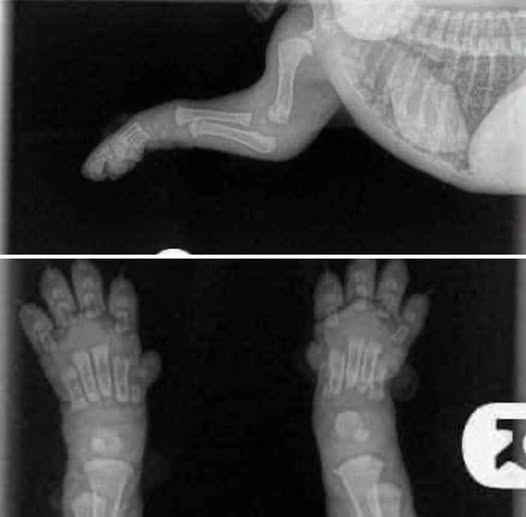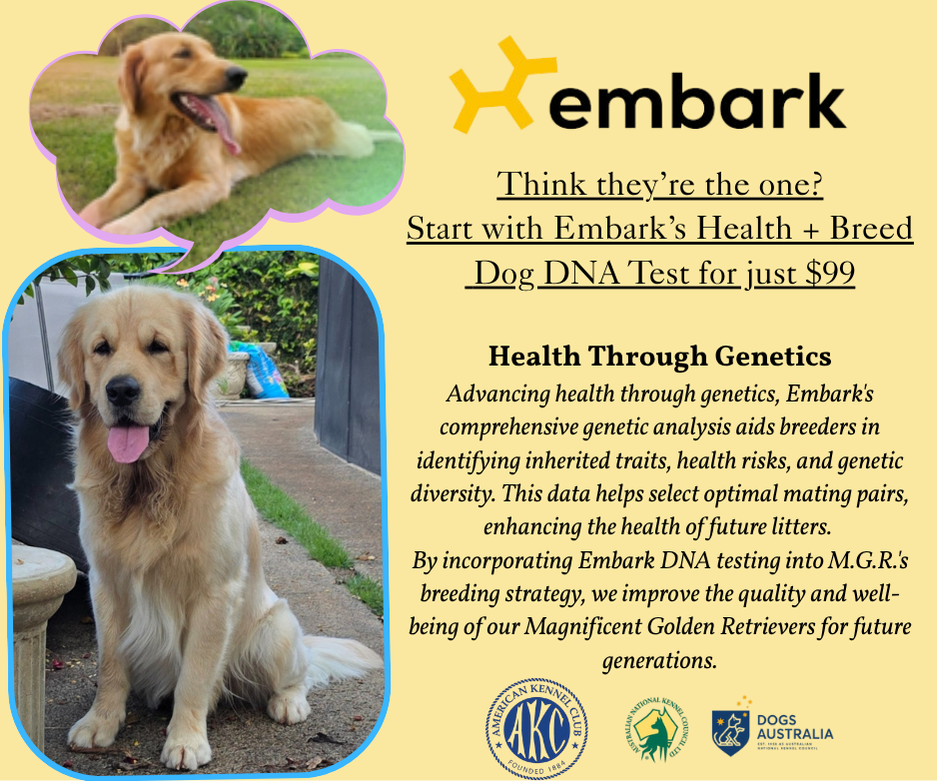Genetically Healthy Studs & Dams
Genetic Testing and DNA Health
At Magnificent Golden Retrievers, we invest in full-spectrum genetic testing for every breeding dog using Embark Dog DNA, which screens for over 270 inherited conditions, including all eleven golden Retriever specific health disorders. What are those specific disorders? Let’s discuss:
We’ve all seen social media posts by new Golden Retriever owners nationwide asking for opinions and advice for their new puppy which displays red, infected patches of skin that don’t subside. Commonly, it’s referred to as “hot spots” and some say Golden Retrievers are just prone to it; that it’s brought on by allergies. However, nothing could be further from the truth.
The underlying cause in many of these cases is ichthyosis, a hereditary condition that compromises the skin barrier, with primary symptoms being described as flakey, dandruffy skin. When the skin barrier is weak, it may no longer function as the body’s first line of defense against bacteria, yeast, and other environmental irritants. This breakdown allows microbes to penetrate and trigger inflammation, leading to sometimes painful, oozing lesions commonly labeled as “hot spots.” Over time, the chronic stress on the skin also weakens the immune system, leaving the dog more vulnerable to secondary infections such as recurring ear infections.
Proper screening and genetic testing can prevent passing this condition to future generations. At Magnificent Golden Retrievers, we use Embark Dog DNA testing to identify carriers and ensure our breeding dogs are clear of ichthyosis. By doing so, we protect not only our lines, but also the families who welcome our Magnificent Golden Retrievers into their homes. A Golden Retriever should not be “prone” to chronic skin disease—responsible breeding and informed puppy selection make all the difference.
Golden Retriever Breed-Specific Health Conditions Tested by Embark
| # | Condition | Gene / Variant | Description |
|---|---|---|---|
| 1 | Ichthyosis, ICH1 & ICH2 | PNPLA1 & ABHD5 (Golden Retriever Variants) | Skin disorder causing flaky scales, infected patches of skin, sometimes greasy skin, and secondary infections like that in the ears. Cracks In skin can allow infection. |
| 2 | Progressive Retinal Atrophy 2 (GR-PRA2) | TTC8 | Retinal disease starting with night blindness and progressing to vision loss. |
| 3 | Progressive Retinal Atrophy, prcd | PRCD Exon 1 | Another PRA variant; gradual vision loss leading to blindness. |
| 4 | Golden Retriever Progressive Retinal Atrophy 1 (GR-PRA1) | SLC4A3 | PRA subtype specific to Goldens, affecting retinal cells. |
| 5 | Neuronal Ceroid Lipofuscinosis 5 (NCL5) | CLN5 (Exon 4 Deletion) | Neurological disease causing progressive nerve cell damage. |
| 6 | Degenerative Myelopathy (DM) | SOD1A | Spinal cord degeneration leading to hind-limb weakness and paralysis. |
| 7 | Muscular Dystrophy | DMD (Golden Retriever Variant) | Weakness and muscle wasting due to dystrophin deficiency. |
| 8 | Congenital Myasthenic Syndrome (CMS) | COLQ (Golden Retriever Variant) | Neuromuscular disorder causing muscle weakness and fatigue. |
| 9 | Dystrophic Epidermolysis Bullosa | COL7A1 (Golden Retriever Variant) | Fragile skin prone to blistering and detachment from minor trauma. |
| 10 | Osteogenesis Imperfecta (“Brittle Bone Disease”) | COL1A1 (Golden Retriever Variant) | Causes brittle bones and tooth fragility; fractures occur easily. |
| 11 | Retina Dysplasia / Optic Nerve Hypoplasia | SIX6 (Exon 1, Golden Retriever Variant) | Developmental eye disorder; underdeveloped retina or optic nerve, leading to vision impairment. |
*Embark records are available to prospective puppy families upon request
By entrusting Magnificent Golden Retrievers to provide you with your new pet family member and furever best friend, you’re choosing a pup that starts life with a clean genetic slate—free from the most well-known inherited disorders in the breed and backed by the most advanced testing available today.
Healthy Hips Promise
All of our breeding dogs undergo PennHIP evaluations and after two years old receive OFA certifications, ensuring we only breed individuals with strong joint structure and proper conformation. But genetics are just part of the story. Hip health is also shaped by how a puppy is raised—through nutrition, growth rate, exercise, and injury prevention. It even goes back to how the breeder helps pups develop their “legs” in the nursery. Early Neural Stimulation (E.N.S.) is a very REAL science. We take this seriously by actively practicing it with all our newborn pups, as well as using passive methods so that pups are always being challenged during this critical developmental period. We truly do our part as responsible breeders and trust that you as lucky adopters will always do your part in taking good care of our precious goldens too (or as we affectionally like to call them, our Boo Bears).
We back our puppies with a 1-Year Healthy Hips Guarantee, which applies to early-onset hip dysplasia that is confirmed to be primarily genetic in origin. This warranty is valid under the following conditions:
- A licensed veterinarian diagnoses the puppy with hip dysplasia.
- The diagnosis is supported by imaging and a medical opinion that genetics—not injury or mismanagement—are the primary cause.
- The puppy has been fed a nutritionally balanced diet as outlined on our page A Pup’s Nutrition:
- An average of two (preferrably three) balanced meals per day from take-home through 6 months of age.
- An average of at least one (preferrably two) balanced meals per day beyond 6 months of age.
- The puppy has not been over-exercised—such as forced running or jogging by leash before 18 months of age and has been afforded ample run/romp/play time outside.
- The puppy has not suffered avoidable trauma (e.g., falling from furniture, roughhousing with large dogs, or being dropped). See warning below.
We strongly encourage all puppy owners to support their growing dog’s joints with glucosamine supplements or a simple homemade beef gelatin and bone broth gravy. Supporting tendon and ligament development during the rapid growth phase is key to long-term orthopedic health.
For enhanced nutrition, we recommend supplementing high-quality kibble (like Member’s Mark brand) with:
- #1 Fresh lean meats (beef, turkey, lamb, chicken, fish, shrimp)
- Locally sourced raw foods such as Beef Organ Blends and Green Beef Tripe from 808 Raw (located on Oahu and Big Island)
- Cottage cheese and plain yogurt dollops -or a slice of homemade probiotic yogurt!(homemade probiotic how-to coming soon) for Great Gut Balance!
- Steamed Broccoli Normandy (from Sam’s Club or Costco)
- Fresh raw or cooked veggies like carrots, broccoli, cauliflower, green beans, cucumbers, zucchini, spinach, peas, celery, pumpkin, and sweet potatoes. They can also eat apples, bananas, blueberries, strawberries, watermelon, cantaloupe, pears, mango, pineapple, raspberries, and cranberries.
Busy day? A high-quality canned food like Nulo Freestyle, and/or fresh, high quality; non-stale kibble such as Member’s Mark from Sam’s Club, is a reliable option when fresh feeding isn’t possible. We feed Members Mark brand kibble from Sam’s Club as a base to most all daily feedings.
Raising your puppy right is just as important as breeding them right. With our guidance—and your commitment—your pup will have the best possible start for a lifetime of strong, healthy movement.
Take a look at this x-ray of a healthy golden retriever puppy. It depicts how fragile they are. We and our friends at Spice of Life Golden Retrievers would like to warn all new puppy parents to understand the following:

“This is something everyone should see!
When you get your 8/10 week old puppies, please keep this image in mind. Their bones do not even touch yet. They plod around so cutely with big floppy paws and wobbly movement because their joints are entirely made up of muscle, tendons, ligaments with skin covering. Nothing is fitting tightly together or has a true socket yet.
When you run them excessively or don’t restrict their exercise to stop them from overdoing it during this period you don’t give them a chance to grow properly. Every big jump or excited bouncing run causes impacts between the bones. In reasonable amounts this is not problematic and is the normal wear and tear that every animal will engage in.
But when you’re letting puppy jump up and down off the lounge or bed, take them for long walks/hikes, you are damaging that forming joint. When you let the puppy scramble on tile with no traction you are damaging the joint.
You only get the chance to grow them once. A well built body is something that comes from excellent breeding and a great upbringing-BOTH, not just one.
Once grown you will have the rest of their life to spend playing and engaging in higher impact exercise. So keep it calm while they’re still little baby puppies and give the gift that can only be given once” –Spice of Life Golden Retrievers



